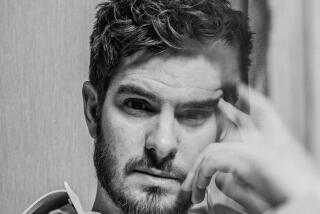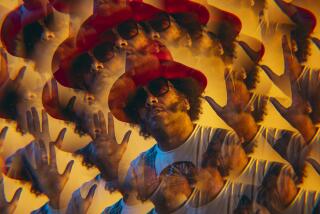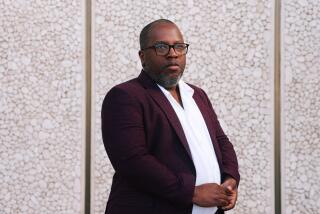Gray’s Play of Passion : Stage: Monologuist Spalding Gray comes to UC San Diego for two nights of exploration into the mysteries of life and his own subconscious.
SAN DIEGO — Spalding Gray, a master monologuist known for his dry humor, hasfound one big advantage to writing and presenting autobiographical stories over the last dozen years: Every day brings new material.
“The work is simply living. To say I’ve begun work on the next piece is to say that I’m alive. My life is the work. Death will end it for me--unless I have the proper medium.”
Gray, 49, spoke on the phone from Scottsdale, Ariz., where he was performing late last week. Friday at 8 p.m. he will present his newest monologue--his 13th--titled “Monster in a Box” at UC San Diego’s Mandeville Auditorium.
On Thursday, he will perform an earlier work, a talk that finishes with a question and answer period, titled “A Personal History of the American Theatre.” In it he recounts his 30 years of experience on the stage.
Although Gray has attracted mixed reviews as an actor, he has been roundly celebrated as a bold, if anguished and insightful, explorer of the mysteries of his own life.
He has attracted a cult following for his performances, particularly because of their long, interlocking stories that often fade in and out of peculiarly absorbing digressions.
His best-known work, “Swimming to Cambodia,” is a monologue about the making of the film “The Killing Fields,” in which he played an American ambassador’s aide. That monologue was published as a book and was released as a film in 1987 to critical acclaim.
Similarly, “Monster in a Box” will be released in book form by Vintage Press in January. It has attracted solid reviews since its New York debut at Lincoln Center in November, followed by live performances that were filmed in March in London. An American release of the film may come as early as January.
But, although a pattern may have evolved in the marketing and touring of Gray’s work, there is no formula to the pieces, Gray says. Each of the monologues, which he has been turning out since 1979, involves an often painful trip into Gray’s subconscious.
In “Monster in a Box,” he deals with the difficult subject of his mother’s suicide, an event that has haunted him since it occurred in 1969.
He said even he did not understand how hard the subject was for him to talk about until he presented his performance in its biggest house to date--New York’s 1,100-seat Vivian Beaumont Theatre.
“After the performance, Renee (Shafransky, his director and fiancee) said, ‘You won’t believe what you left out.’ I said, ‘I didn’t leave anything out. It was wonderful. It was a wonderful performance.’ She said, ‘Sit down.’
“I had left out the line where I say (quoting his mother), ‘How shall I do it dear? How do I do it? Should I do it in the garage in the car?’ ”
Gray’s mother did, in fact, kill herself in a car in her garage a year after she asked him that question--a question he never shared with anyone until after she died. Afterward, he said, he kept asking himself, “Why didn’t I hide the keys? Why didn’t I tell my father?”
“I realized at that point (after the New York performance) that I still had a private, protective place around that material. It’s still hard each time, and I expect it to be. Each time, you’re reliving it.”
The material is so painful that Gray’s own father and stepmother have chosen not to see “Monster in a Box.” But, then, the actor speculates that his father has seen at most only two of his son’s monologues.
“I think it’s upsetting for them because I work with very personal things. They’re from New England, and they don’t want their personal lives revealed. When my mother was dead, the obituary said she died from a long illness. He is an old man, and he would prefer to forget about the suicide,” Gray said of his 79-year-old father.
Part of Gray’s desire to reveal himself “is reactionary,” he said--a response to his father’s refusal to talk about his emotions.
Part also comes from his early theatrical training. Five years after graduating from Emerson College in Boston, he moved to New York to work in underground theater and walked into what he has called “a caldron of creativity,” which included the Open Theater, and people such as Joseph Chaikin, Merce Cunningham, Meridith Monk and Charles Ludlam.
Five years after that, he co-founded New York’s avant-garde Wooster Group with Elizabeth LeCompte, an artist and theater director he met in Saratoga, N.Y. It was in the Wooster Group that he first began to use autobiographical material.
In a piece called “Three Places in Rhode Island”--Gray was born in Rhode Island in 1941--he included tapes of interviews he had conducted with members of his family after his mother’s death.
Then, too, he said, part of the drive to reveal himself comes from the influence of Shafransky, a screenwriter and producer who he plans to wed Aug. 23, after 13 years of living together.
Of course, “Monster in a Box” is not just about the death of Gray’s mother, any more than any of Gray’s monologues end up being solely about what they ostensibly set out to cover.
“Monster In a Box” is also filled with digressions about the pressures of fame that followed him after “Swimming to Cambodia,” which included acting stints in such movies as “Clara’s Heart” and “Beaches.”
It is also about trying to write--or rather avoid writing--a novel based on the death of his mother, a book that Gray has in fact completed. (Titled “Impossible Vacation,” the book is his first work of fiction and is due out this fall from Knopf.)
The monologue’s title, “Monster in a Box,” refers at once to the manuscript of the book, which is stored in a box, and to his mother’s ashes, which are stored in an urn.
“Monster in a Box” also has provided Gray with the chance to get back at those New York critics whose reviews of his role as the stage manager in “Our Town” left him “devastated.”
These critics included Frank Rich of the New York Times, who said Gray’s “blase Tribeca hipness belongs to another planet.” The same critics laughed when they, in turn, were put down in “Monster in a Box,” and they gave the show good reviews.
Gray said he hopes to do more film work, but made clear that he does not expect to do any more stage work that he has not written himself.
He is already at work on his next piece, tentatively titled “Gray’s Anatomies,” which ostensibly is about an eye operation he had in August of 1990.
The piece also deals with turning 50, facing his own mortality as well as what he calls the attendant issues of “science versus conscience and religion and Christian Science (his mother’s belief) and faith and disease.”
He will perform six shows of “Monster in a Box” in New York at the end of May, followed by performances at the Los Angeles Theatre Center in June. But, he said, the pace is getting to him.
“I’m over the edge right now,” he said. “I shouldn’t be out here. I’m here because I booked this tour a year ago. I have all sorts of mixed feelings.”
But two things he doesn’t have mixed feelings about are his desire to have a child with Shafransky--something they are now trying to do--and his need to keep writing his monologues.
Although he enjoys acting, he finds no role is better for him than playing himself.
“I can’t really bring the strength of honest emotions to someone else’s lines. When I do the lines from ‘Our Town,’ they don’t have the same connection that the real stories from my life do. Once I discovered doing my own work, I realized I could never go back and do a playwright’s work in the same way.”
There is also no substitute for the emotional release he gets from sharing the feelings he was taught to keep to himself in his early years.
“One of the things that I missed in my life was the sharing of what it is to live in the world. My father doesn’t do that. He won’t answer personal questions to this day. My mother did, but I lost her. . . . The one thing I can do, since I don’t have children, is share that with an audience. I see that as a way of communicating and also as a way of bringing communal wisdom to people--something that was so lacking in my family.”
More to Read
The biggest entertainment stories
Get our big stories about Hollywood, film, television, music, arts, culture and more right in your inbox as soon as they publish.
You may occasionally receive promotional content from the Los Angeles Times.










